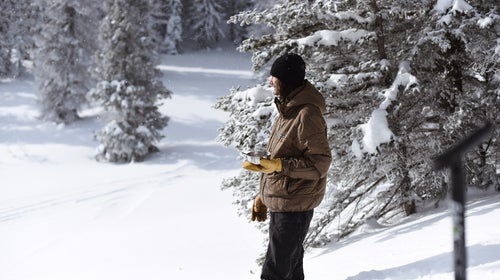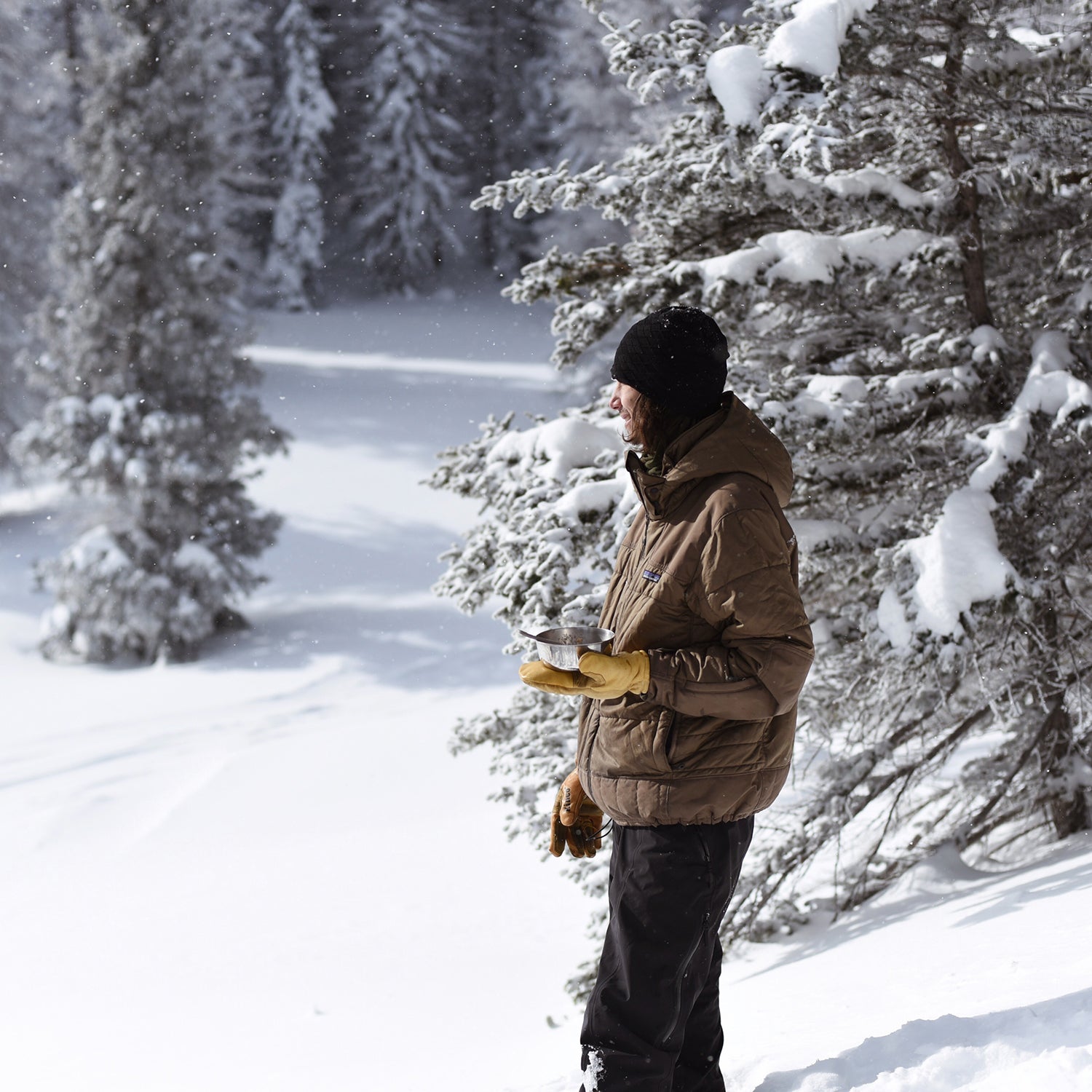To the relief of cooped-upÌıpowder hounds everywhere,Ìıskiing has proved to beÌırelatively safe during the pandemic, thanks to the abundance ofÌıfresh air and natural social distancing on the hill. But oneÌıaspect of a day at the resortÌıstill poses significant COVID risk: the ski lodge.ÌıTo avoid crowded indoor spaces,Ìımany ºÚÁϳԹÏÍø editors have beenÌıtrading their slopesideÌıburgers andÌıchicken fingers for meals prepared at home.Ìı
But whichÌıbrown-bagÌılunches are best for getting you through a day at the resort? We rounded up the ºÚÁϳԹÏÍøÌıstaffâsÌıfavorite to-go meals, below, then asked , the director of sports nutrition for Stanford University athletes, to weigh in on ourÌıchoices.ÌıGravani, a former college ski racer, says there are three componentsÌıofÌıa goodÌıto-go meal:Ìı
- The right balance of nutrients. Generally, you want your mealÌıto be higher in carbohydrates, with a moderate amount of fat and protein.ÌıCarbohydrates are a skierâsÌımain fuel source, andÌıa little fat and protein help stave off hunger longer while providing slowly releasedÌıenergy. (Exact proportions will vary depending on your individual nutrition needs, but typically,Ìıthe more intense and sustained your ski day is, the more this ratio will skew toward carbs.)
- IngredientsÌıthat sit well inÌıyour stomach. If you know that spicy chili makes you sprint for the bathroom, leave the beans at home. The less your stomach is churning, the more you can enjoy your turns.
- Food safety. If youâre carrying a meaty burrito around in your pocket, thatâs the ideal habitat for bacteria that causes foodborne illness. Ideally, you want to keep perishable foods cold, or just stick with shelf-stable options.Ìı
With those criteriaÌıin mind, hereâs what Gravani thinks aboutÌıºÚÁϳԹÏÍø editorsâ ski-day lunches:
Breakfast Burritos
Pandemic or not, my go-to is a homemade breakfast burrito: a ten-inch tortilla, hash browns, scrambled eggs, cheddar cheese, and green chili. Itâs really two meals in one. I eat one half on the drive to the mountain, then wrap the other half in tinfoil and stash it in my jacket for lunch. That, plus an energy bar in reserveâIâm a fan of Ìıflavorâalways gets me through the day. âChris Keyes, editorÌı
I have two go-to ski lunches, depending on how muchÌıI rallied that morning. If IâveÌıgiven myself enough time to get a breakfast burrito from my favorite spot in Santa Fe (hello,Ìı!), I will eat exactly one-thirdÌıof it for lunch, with a Modelo on the chairlift. (The first thirdÌıis consumedÌıon the drive up in the morning, and the last third on the drive down at the end of the day.)ÌıBetterday burritos are made up of fiveÌıkey ingredients: tortilla, egg, cheese,ÌıandÌıchile. SometimesÌıbacon, too.ÌıIf my morning is rushed (or my bank account strained), IâllÌıeat a Ìıfor lunchâitâsÌımy favorite on-the-go snack. ItsÌımacros are pretty well-balanced, so it feels less like a sugar orÌıprotein bomb and more like a meal. I also wash thatÌıdown with a Modelo. âAbbie Barronian, associate editorÌı
GRADE:ÌıB
âYouâve got really good combinations of carbs, fat, and protein,â says Gravani of the two burritos. The tortilla and hash browns provide a nice boost of carb-based energy, while the eggs and cheese round things out with protein and fat. GravaniÌıthinksÌıthe GoMacroÌıand Perfect bars areÌıalsoÌısolid choices. Food safety in regards to the burritos, however, docks themÌıa grade. âWhen you put a warm burrito in your pocket,ÌıkeepingÌıthat moderate temperature as itâs cooling down over timeÌıputs it at risk for microbial growth,â she says. If youâre going to go with a perishable lunch, itâs better to refrigerate it first.Ìı
Quesadillas
MyÌıgo-to lift lunch is the eggadilla. First, fry two eggs, making sure to break the yolksÌıso they donât run all over your gloves when itâs time to eat. Then sautéÌıwhatever veg you have on handâonion, bell pepper, zucchini, etc. Finally, stackÌıyour eggadilla on a tortilla, with a layer of cheese on the bottom, your egg and veg in the middle, and another layer of cheese on top, and then add the second tortilla. Heat the whole thing in a large frying pan, or just microwave it. Cut it into quarters, and put it in a Ziploc bag, so you can throw in your pack or even aÌıjacket pocket. Itâs portable, squish-proof, delicious, and filling. âLuke Whelan, senior research editor
An excellent ski lunch consists of a few triangle-shaped sections of leftover, cold, homemadeÌıquesadillaâI use flour tortillas, sautéedÌımushrooms, chopped chicken breasts, Mexican-blend cheese, and canned green chile. It carries well, because itâs already flat. I also take along some good salsa in a small, leakproof container. âAlex Heard, editorial director
GRADE: B
âI love the addition of vegetables here,â says Gravani. âAlong with that lean protein and carbs, it seems like a nice combination.â The quesadillas, above, have a similar protein-fat-carbs ratio to the breakfast burritos, making them a well-balanced choice for a midday ski meal. But they also lose points for the elevated potential to bring on a bout of foodborne illness.
Frito Pie
I always bring a thermos of good-quality chili,Ìılike Annieâs, and a bag of Fritos. When Iâm feeling fancy, Iâll top the chili with shredded TillamookÌıwhite cheddar. Bonus: itâs gluten-free, which is a must when you have celiac like I do. âAleta Burchyski, associate managing editorÌı
My boyfriend and I are known for only bringing Frito piesÌıon backcountry and camping trips. Itâs what we ate growing up at the Santa Fe ski area, and weâve been continuingÌıthe tradition during the pandemic. WeÌıbring a bag of Fritos, a thermos of hot beef chili, and sometimes also a bag of shredded lettuce and cheese.ÌıItâsÌıfull of carbs, protein, and saltâwhat more could you ask for! WeÌıaccompany the meal with a thermos of hot chocolate or tea.ÌıAnd as any ski day should have, a candy bar will always be on hand. âPetra Zeiler, art director
GRADE: B-
âI give them points for being able to navigate that meal and bring it heated,â says Gravani. And while theÌımacronutrient balance is decent, this mealâsÌıpotential to cause tummy troubles warrantedÌıa grade reduction. The combo of fat, fiber, and spice can lead to an upset gut. âEspecially with beans, it canÌıcause GI distress for some people,â she says. Being at a high altitude doesnât help the stomach situation either.ÌıSome people may have no issue with the magical fruits, and GI problems are very individual,Ìıbut if youâre unsure about your reaction to beans,Ìıyou may want to save yourselfâand everyone in your groupâthe trouble.Ìı
PB&J
I keep it simple with an almond butter and jam sandwich, usually on Trader Joeâs Super Grain and Seed bread. I pack on the almond butter, and go light on the jam so it doesnât get all sticky,Ìıand put it in a small ZiplocÌıbag. Itâs great fuel, and I can cram it in a ski-jacket pocket and eat it on the lift. It doesnât matter if it gets smashed. In fact, it tastes better smashed a bit, because the jam marinates the bread. I also always keep some peanut M&Mâs or a Kind barÌıin my pocket for extra fuel when needed. âMary Turner, deputyÌıeditor
PB&J all the way! This sandwich is a classic and might be the ultimate-adventure pocket snack; we even have articles to prove it. ButÌıI donât make just any old PB&Jâif itâs going in my pocket, it has to be a âdubâÌıPB&J.ÌıInstead of loading up just one side of the sandwich with peanut butter, I prefer to coat each slice of bread with a thin layer of peanut butter, and then addÌıthe jelly in the middle. This is key for keeping your PB&J al denteÌıall day, an improved sandwich structure for zero sogginess and better pocket durability for the inevitable yard sale. If youâre looking for something a little more gourmet, just add bacon. âJackson Buscher, video producer
GRADE: A
Itâs hard to beat the humble PB&J. Not only does it meet the right balance of nutrients that you need to keep skiing through the afternoon, but itâs also easy to digest and shelf-stable. Gravani herself likes to pack a PB&J when she hits the slopes. âHaving a less heavy lunch, and being able to supplement with some snacks, sets you up to avoidÌıthat post-lunch slump,â she says. Chairlift grazing not only reserves more time for skiingÌıbut also can keep you energized throughoutÌıthe day.Ìı
Cold Pizza
During ski season, Friday nights at my house are usually pizza nights. Homemade pies loaded with cheese, veggies, and pepperoni areÌıthe ultimate comfort food and the best way to cap off a stressful workweek. The leftovers also make the best ski lunch imaginable. My boyfriend and I always make extra to bring to the mountain the next day. A few slices fit neatly into a ZiplocÌıthat lies flat in my jacket pocket, and theyâre easy to eat one-handed (and glove-handedÌıif itâs frigid and Iâm really desperate). It feels more indulgent than the usual PB&J or energy barÌıbut is still easy to snack on during lift rides without making a mess. Plus, cheese and bread are good endurance fuels, right? âAriella Gintzler, associate editor
GRADE: B-
A cheesy slice contains moreÌıfat than would be ideal midway through a ski day, according to Gravani. That means you may feel sluggish after eating it, as fats tend to sit heavier in the stomach and digest slower than carbs and protein.Ìı
Tortilla Wrap
With a kid at home, Iâm all about efficiency on the slopes. My go-to lunch is a simple flour-tortilla wrap with peppered salami, cheddar cheese, avocado, and hot sauce. Itâs easy and tidy to eat on the run, but the protein hit gives me sustained energy without bogging me down. âWill Taylor, gear director
GRADE: A-
âI do love that heÌıchose a shelf-stable meat, and the rest of the components are really quality, too,â says Gravani. Salami is still a fattyÌımeat, though, so swapping it out with a low-fat alternative like turkey would make this meal perfect and help avoid post-meal sluggishness.
Cheese and Crackers
Since I wonât be able to treat myself with chicken fingers and ranch dressing this yearâthe absolute best ski lunch, in my opinionâIâll be packing my favorite backpacking meal: cheese and crackers. I prefer a solid hunk of cheddar cheese paired with Wasa Multi-Grain crispbread. And Iâll throw in a beef stick or jerky if I get really hungry. âKelsey Lindsey, associate editor
GRADE: B+
âThis one is lower proteinÌıand higher fatÌıthan is ideal,â says Gravani. Adding in a lean meat like turkey jerky to increaseÌıthe protein would achieve a better nutrient balance.


